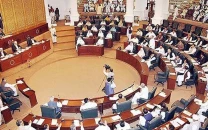Energy shortages, low investment take toll
Industrial sector struggling with modest 2.3% growth in first half.

Industrial sector struggling with modest 2.3% growth in first half. STOCK IMAGE
“In order to address these issues and to put the economy on a higher growth trajectory, bold policy measures along with better overall governance are inevitable,” the bank said in its second-quarter (Oct-Dec) report, which was presented to parliament on Friday.
However, the economy ended the first half of fiscal year 2014-15 with some positive developments, though it faced difficulties in initial months.
The positive developments included a decade-low inflation, contained budget deficit along with improved financing mix, comfort in balance of payments mainly on the back of a sharp decline in global oil prices, increase in foreign exchange reserves and stability in the exchange rate.
According to the report, preliminary information suggests a mixed picture of the economy. Prospects of a better wheat crop and some improvement in minor crops are likely to offset the sluggish performance of cotton and sugarcane.
However, farmer incomes may be adversely affected by higher input cost, especially of fertiliser, and the decline in prices of cash crops.
On the other hand, according to the report, the industrial sector is struggling with energy issues, as evident from a modest growth in the large-scale manufacturing sector.
“In the services sector, it seems challenging for some sub-sectors, like wholesale and retail trade, to achieve their growth target, while others, like banking, can perform well.”
The report said low inflationary outlook allowed the central bank to reduce interest rate in monetary policy announcements from November 2014 onwards. The policy rate has been brought down to 8%.
In terms of fiscal performance, the budget deficit as a percentage of gross domestic product (GDP) was 2.2% in the first half of the year, slightly higher than last year’s level.
The government (federal and provincial combined) was able to contain expenditure growth to 4.8% during the period, compared with 10.7% in the same period a year earlier.
However, revenue collection continued to be a major concern. Total revenues (federal and provincial) grew only 5% in the first half compared with 13.9% last year.
The exchange rate is expected to remain stable, which coupled with low fuel prices, will continue to dampen inflationary expectations.
Published in The Express Tribune, May 16th, 2015.
Like Business on Facebook, follow @TribuneBiz on Twitter to stay informed and join in the conversation.



















COMMENTS
Comments are moderated and generally will be posted if they are on-topic and not abusive.
For more information, please see our Comments FAQ